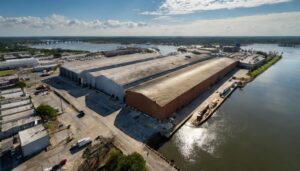- Demand Dynamics: Charleston’s industrial market has experienced softened demand, shifting from its long-term strong demand drivers.
- Speculative Construction: A record level of speculative construction has commenced, contributing to the changing market landscape.
- Port Activity: Container activity at the Port of Charleston is stabilizing, impacted by inflation and economic uncertainty affecting consumer buying power.
- Market Shift: A notable market share shift from West Coast to East Coast ports is occurring, potentially benefiting Charleston.
- Infrastructure Improvements: Upgrades like the Charleston Harbor’s dredging to 52 feet and the new Hugh K. Leatherman Terminal will support market expansion.
- Vacancy Rates: As new supply hits the market, vacancy rates have started to climb from historically low levels, with further increases anticipated.
- Inventory Growth: Charleston is witnessing a significant 10.5% inventory growth, placing it among the fastest-growing industrial markets.
- Leasing Activity: Despite rising vacancies, major firms like Walmart, UPS, Bosch, and Redwood Materials continue to secure substantial leases.
- Investment Trends: Recent years have seen increased investment interest, particularly from out-of-state buyers, though recent economic pressures have dampened sales volumes.
- Market Outlook: The industrial market in Charleston is transforming, with continued growth and evolving challenges as new constructions and economic factors play out.
Page Contents
- Softening Demand Dynamics
- Port Activity Stabilization
- Shift in Market Share
- Rising Vacancies
- Rapid Inventory Expansion
- Significant Leasing by Major Firms
- Out-of-State Investment Interest
- Leasing Slowdown Amidst Economic Shift
- Continued Demand for Distribution Hubs
- Supply-Demand Mismatch Leading to Higher Vacancies
- Rental Rate Dynamics
- Demand Drivers and Rent Trends
- Construction Surge and Rent Softening
- Submarket Performance
- Varied Asking Rents in New Developments
- Groundbreaking Trends
- Speculative Builds and Leasing Success
- Dominant Submarkets Expanding
- Expansion Beyond Traditional Boundaries
- New Developments Attracting Tenants
- Final Thoughts
Softening Demand Dynamics
Demand in Charleston’s industrial market softens. Speculative construction rises, impacting market dynamics.
Demand Softening and Construction Spike:
In Charleston, industrial demand is softening. Meanwhile, speculative construction hits record levels, altering the market.
 Port Activity Stabilization
Port Activity StabilizationThe Port of Charleston’s container activity levels out, influenced by economic factors.
Container Activity Levels Off:
At the Port of Charleston, container movement stabilizes. Economic uncertainties affect consumer spending, impacting port activity.
East Coast ports, including Charleston, gained market share thanks to infrastructure improvements.
Charleston benefits from a shift in market share from the West to the East Coast. Infrastructure upgrades like harbor dredging support this trend.
Rising Vacancies
New industrial supplies push Charleston’s vacancy rates up despite historically low levels.
Increasing Vacancy Rates:
Charleston sees rising industrial vacancies due to new speculative constructions, even as rates remain below the national average.
Rapid Inventory Expansion
Charleston’s industrial inventory proliferates, marking it as a fast-evolving market.
Fast-Growing Industrial Market:
With a 10.5% inventory growth, Charleston stands out as a rapidly expanding industrial market, challenging the status quo.
Significant Leasing by Major Firms
Major leases in Charleston obscure the broader market’s slower demand.
Major Firms Drive Leasing Activity:
Despite a slowdown in demand, significant leases like Redwood Materials in Camp Hall significantly influence Charleston’s leasing statistics.

Out-of-State Investment Interest
Out-of-state investors show keen interest in Charleston, even as economic uncertainties cool the investment climate.
Investment Attraction Amid Economic Shifts:
Investors outside the state remain interested in Charleston’s industrial sector, although economic shifts have tempered overall investment enthusiasm.
Leasing Slowdown Amidst Economic Shift
Leasing activity in Charleston shows signs of slowing as market conditions evolve.
Moderating Leasing Activity:
Charleston’s leasing activity has started to moderate. The shift from goods to services in consumer spending affects the industrial market.
Continued Demand for Distribution Hubs
Charleston’s strategic position and workforce potential are attractive as a distribution hub.
Strategic Distribution Hub Potential:
With its growing workforce and industrial portfolio, Charleston remains appealing for tenants, especially as a Southeastern U.S. distribution center.
Supply-Demand Mismatch Leading to Higher Vacancies
Record supply levels in Charleston will likely increase vacancies through 2023.
Surging Supply Over Demand:
Record supply levels in Charleston will likely drive up vacancies through 2023.
Rental Rate Dynamics
Charleston’s average asking rents are below the national average, with logistics seeing significant increases.
Changing Rent Patterns:
Charleston’s industrial rents average at $9.90/SF. At $8.90/SF, logistics shows the fastest growth despite national trends.
Demand Drivers and Rent Trends
Increased Southeast goods spending and population growth have spiked warehouse demand, influencing rents.
Market Demand and Rent Impact:
As the Southeast’s economy grew, so did the Port of Charleston’s import volumes, driving warehouse demand and affecting rents.
Construction Surge and Rent Softening
Speculative construction increases, potentially easing rent hikes as supply outpaces demand.
Speculative Construction’s Effect on Rents:
Charleston’s recent construction boom may soften rent growth as new space availability increases amid declining import volumes.
Submarket Performance
Certain areas in Charleston show robust rent growth, even with expanding inventory.
Submarket Rent Growth:
In Charleston, areas like Outlying Berkeley County and North Charleston excel in rent increases, despite inventory spikes.
Varied Asking Rents in New Developments
New constructions in Charleston advertise varied rents, reflecting market diversity and strategic pricing.
New Developments and Rent Variability:
Large-scale developments in Charleston, like Ladson Industrial Park and Palmetto Trade Center, offer competitive rents, showcasing market dynamics.
Groundbreaking Trends
Industrial groundbreakings in Charleston decreased from 2022 highs, reflecting a response to import growth.
Post-Boom Adjustments in Construction:
After peaking in 2022, Charleston’s industrial groundbreakings are slow, yet 10.9 million SF of development is in progress, adding to recent completions.
Speculative Builds and Leasing Success
Speculative construction rises, with a high lease rate for completed projects, signaling market confidence.
Leasing in New Speculative Spaces:
Build-to-suit projects like Walmart’s distribution center set the trend, shifting towards speculative builds with significant pre-leasing success.
Dominant Submarkets Expanding
Outlying Berkeley County and North Charleston lead in industrial space, showing substantial growth and strategic location benefits.
Strategic Growth in Key Submarkets:
These areas dominate Charleston’s industrial landscape, offering critical access to transportation and accounting for most new developments.
Expansion Beyond Traditional Boundaries
With limited port-adjacent land, Charleston’s industrial development extends inland, marking new growth corridors.
Inland Expansion for Industrial Development:
As coastal land becomes scarce, developments like Port 95 Industrial Park push Charleston’s industrial footprint further inland, tapping new areas.
New Developments Attracting Tenants
Recent projects, including Trade Park East, were fully leased before completion, indicating strong market demand.
Fully Leased New Developments:
Projects like Trade Park East in Ladson, fully leased upon delivery, illustrate the continued appeal of North Charleston for industrial tenants.
Final Thoughts
In conclusion, Charleston’s industrial market shows robust growth, strategic expansions, and vigorous leasing activity. Key submarkets are driving developments, reflecting the region’s economic dynamism. To navigate these investment opportunities, contact Lumicre for tailored advice and insights—Trust Lumicre to guide your investment journey in Charleston’s thriving industrial landscape.